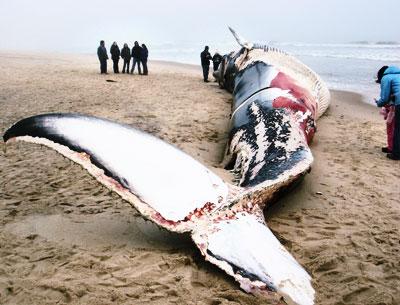Two Whales Beached in Amagansett

A dead female finback whale, estimated to weigh about 58 tons, was beached on Napeague on Sunday, the same day that a young male pygmy sperm whale washed up, still breathing, about three miles down the beach in Amagansett.
Though the beaching of two whales in one day may have seemed like an unusual coincidence, Kim Durham, rescue program director for the Riverhead Foundation for Marine Research and Preservation, explained that their proximity was related to the ocean currents, which take marine mammals when they are in a weakened state.
The pygmy sperm whale “wasn’t a candidate for rescue,” Ms. Durham said on Monday morning. The team assessed the five-and-a-half-foot mammal at 160 pounds, and found him in severely compromised health, emaciated, with labored breathing and thermal lesions, she said. The whale was euthanized by injection on Sunday, and its remains were taken to Riverhead. The cause of the whale’s illnesses had not been determined and the foundation did not venture any guesses.
As for the finback’s cause of death, Ms. Durham believed it was a ship strike. She pointed Monday morning to the exposed underside of the whale, which was lying on its side, partially submerged in the water. A large black mark between its fins, approximately three feet in length, lined up horizontally with the fin below it, which bore a mark of almost the same size and shape. The strike area appeared to be surrounded by bruising, she said. In addition to those wounds, scarring on the whale’s tail indicated her entanglement in a fishing net at some point in her life, Ms. Durham said.
On Tuesday evening, Rob DiGiovanni, the foundation’s executive director and senior biologist, confirmed that blunt-force trauma was the cause of death. He said that abrasions and bruising beneath the whale’s skin provided evidence of a collision, while she was alive, with something hard and large in the water. Although “nobody was there to see it,” he said this is usually indicative of a sea vessel. Her severe decomposition indicated she was dead for about two weeks before washing up on the beach, he said.
After completing a necropsy on the pygmy sperm whale on Tuesday, Mr. DiGiovanni said that preliminary findings uncovered bleeding ulcers in its stomach, an excessive nematode infestation (roundworms), and peritonitis, a bacterial or fungal infection of the inner abdominal wall. “Any one of these issues is a severe condition,” explained Mr. DiGiovanni.
With the finback whale landing at the end of a path from the road to the ocean, many residents, including a busload of children, saw the enormous creature up close on Sunday and Monday.
As the whale rocked back and forth with breaking waves at the water’s edge, a team of volunteers gathered at the site on Monday and waited for the tide to go out before a crane pulled the whale’s tail toward the beach, to enable examination. Due to the strong stench of decay and potential spray of fluids, the whale was positioned so that the wind would not carry either toward those who worked on her.
Many spectators were fascinated with the whale’s mouth and baleen, but Ms. Durham warned that a decomposing mammal presents “an amazing buffet of bacteria,” which can cause illness. Chief Edward Michels of East Hampton Town’s marine patrol was on the scene to secure public safety, by delineating a viewing area with police tape.
Rodney Smith of the Shinnecock Nation came to pay his respects, and performed a ritual that included an offering of tobacco in four directions and the burning of sage around the whale.
When conditions permit, whales can be buried on the beach, but according to Mr. DiGiovanni, local officials and environmental agencies decided to cart the whale off premises for disposal, after the remains were documented with the National Marine Fisheries Service.
A finback whale can grow to as long as 75 feet; a pygmy sperm whale can reach a maximum of 14 feet.
Had the pigmy sperm whale been viable for rescue, there would have been a problem, since the foundation’s tank is currently occupied by a harbor porpoise, and mixed breeds in tanks are not an option. The porpoise, which is being fed and doing well according to Mr. DiGiovanni, may be released in a month or so. Pictures of the porpoise can be found on the foundation’s Web site, riverheadfoundation.org.
